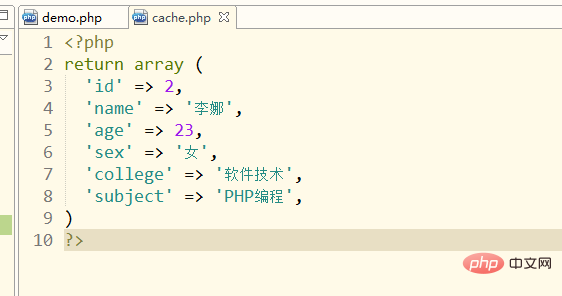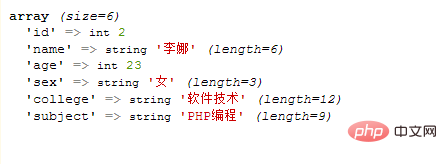 Backend Development
Backend Development
 PHP Problem
PHP Problem
 PHP file operation: how to save array data to a file (two methods)
PHP file operation: how to save array data to a file (two methods)
PHP file operation: how to save array data to a file (two methods)
In the previous article "How to check for null values using PHP (4 methods)", we introduced the method of using PHP to check whether a given value (variable) is null. This time we will talk about data storage in PHP and see how to store array data in a specified file. Interested friends can learn about it~
→Related recommendations: 《php file operation series summary (continuously updated~)》
During the development process, we often use var_dump() to print the array content, but sometimes it is inconvenient for us to view debugging information through the browser. At this time, the information can be output to a file for viewing. Today, this article will introduce to you two methods of writing array data to files.
Method 1: Use the var_export() function
var_export - Output or return the parsable string representation of the variable
Syntax: var_export(mixed $value, bool $return = false)
value: The variable name you want to output.
return: When this parameter is true, var_export() will return a variable instead of outputting it.
This function returns structural information about the variables passed to the function. It is similar to var_dump(), except that the representation returned is legal PHP code. We can return a representation of a variable by setting the second parameter of the function to TRUE.
Let’s use the following example to see how to use the var_export() function to save array data into a file
<?php
//$cache的值是更新缓存时从数据库中取出来的
$cache = array(
'id' => 2,
'name' => '李娜',
'age' => 23,
'sex' => '女',
'college' => "软件技术",
'subject' => "PHP编程"
);
//将数据写入缓存文件
$content = "<?php\nreturn ".var_export($cache,true)."\n?>"; //这里使用var_export()
file_put_contents('./cache.php', $content);
?>Analysis code:
- ##Utilization
var_export($cache,true)
Return the parsable string of the array variable - ##$content = "";
Concatenate the strings and assign the value to the variable $content;
- file_put_contents('./cache.php' , $content)
Write data
php file operation: how to clear the file and re-add data$contentin the cache.php file.The file_put_contents() function can write a string into a file. For details, you can read the article "So in cache.php, which was an empty file at the beginning, the current content is:
 Call the cache file You only need to use require() to copy the contents of the cache file to a variable, and then output the array variable:
Call the cache file You only need to use require() to copy the contents of the cache file to a variable, and then output the array variable:
<?php $cache = require('./cache.php'); var_dump($cache); ?>
The output result is:

Method 2: Use the serialize methodUse serialize to serialize the array and store it in the file; when calling, use unserialize to restore it.
Let’s use the following example to see how to use the serialize() function to store array data into a file
<?php
$file='./cache.php';
$cache = array(
'id' => 2,
'name' => '李娜',
'age' => 23,
'sex' => '女',
'college' => "软件技术",
'subject' => "PHP编程"
);
//缓存
if(false!==fopen($file,'w+')){
file_put_contents($file,serialize($cache));//写入缓存
}
?>Use
file_put_contents($file,serialize($cache)) Store the serialized array data in the cache.php file. Therefore, in cache.php, which was an empty file at the beginning, the current content is:
 When reading the cache, you need to use unserialize to restore the data in cache.php
When reading the cache, you need to use unserialize to restore the data in cache.php
<?php //读出缓存 $file='./cache.php'; $handle=fopen($file,'r'); $cache=unserialize(fread($handle,filesize($file))); var_dump($cache); ?>
The output result is:
)
PHP interview questions summary (collection)》《php video tutorial》
The above is the detailed content of PHP file operation: how to save array data to a file (two methods). For more information, please follow other related articles on the PHP Chinese website!

Hot AI Tools

Undresser.AI Undress
AI-powered app for creating realistic nude photos

AI Clothes Remover
Online AI tool for removing clothes from photos.

Undress AI Tool
Undress images for free

Clothoff.io
AI clothes remover

Video Face Swap
Swap faces in any video effortlessly with our completely free AI face swap tool!

Hot Article

Hot Tools

Notepad++7.3.1
Easy-to-use and free code editor

SublimeText3 Chinese version
Chinese version, very easy to use

Zend Studio 13.0.1
Powerful PHP integrated development environment

Dreamweaver CS6
Visual web development tools

SublimeText3 Mac version
God-level code editing software (SublimeText3)

Hot Topics
 1386
1386
 52
52
 PHP 8.4 Installation and Upgrade guide for Ubuntu and Debian
Dec 24, 2024 pm 04:42 PM
PHP 8.4 Installation and Upgrade guide for Ubuntu and Debian
Dec 24, 2024 pm 04:42 PM
PHP 8.4 brings several new features, security improvements, and performance improvements with healthy amounts of feature deprecations and removals. This guide explains how to install PHP 8.4 or upgrade to PHP 8.4 on Ubuntu, Debian, or their derivati
 How To Set Up Visual Studio Code (VS Code) for PHP Development
Dec 20, 2024 am 11:31 AM
How To Set Up Visual Studio Code (VS Code) for PHP Development
Dec 20, 2024 am 11:31 AM
Visual Studio Code, also known as VS Code, is a free source code editor — or integrated development environment (IDE) — available for all major operating systems. With a large collection of extensions for many programming languages, VS Code can be c
 7 PHP Functions I Regret I Didn't Know Before
Nov 13, 2024 am 09:42 AM
7 PHP Functions I Regret I Didn't Know Before
Nov 13, 2024 am 09:42 AM
If you are an experienced PHP developer, you might have the feeling that you’ve been there and done that already.You have developed a significant number of applications, debugged millions of lines of code, and tweaked a bunch of scripts to achieve op
 How do you parse and process HTML/XML in PHP?
Feb 07, 2025 am 11:57 AM
How do you parse and process HTML/XML in PHP?
Feb 07, 2025 am 11:57 AM
This tutorial demonstrates how to efficiently process XML documents using PHP. XML (eXtensible Markup Language) is a versatile text-based markup language designed for both human readability and machine parsing. It's commonly used for data storage an
 Explain JSON Web Tokens (JWT) and their use case in PHP APIs.
Apr 05, 2025 am 12:04 AM
Explain JSON Web Tokens (JWT) and their use case in PHP APIs.
Apr 05, 2025 am 12:04 AM
JWT is an open standard based on JSON, used to securely transmit information between parties, mainly for identity authentication and information exchange. 1. JWT consists of three parts: Header, Payload and Signature. 2. The working principle of JWT includes three steps: generating JWT, verifying JWT and parsing Payload. 3. When using JWT for authentication in PHP, JWT can be generated and verified, and user role and permission information can be included in advanced usage. 4. Common errors include signature verification failure, token expiration, and payload oversized. Debugging skills include using debugging tools and logging. 5. Performance optimization and best practices include using appropriate signature algorithms, setting validity periods reasonably,
 PHP Program to Count Vowels in a String
Feb 07, 2025 pm 12:12 PM
PHP Program to Count Vowels in a String
Feb 07, 2025 pm 12:12 PM
A string is a sequence of characters, including letters, numbers, and symbols. This tutorial will learn how to calculate the number of vowels in a given string in PHP using different methods. The vowels in English are a, e, i, o, u, and they can be uppercase or lowercase. What is a vowel? Vowels are alphabetic characters that represent a specific pronunciation. There are five vowels in English, including uppercase and lowercase: a, e, i, o, u Example 1 Input: String = "Tutorialspoint" Output: 6 explain The vowels in the string "Tutorialspoint" are u, o, i, a, o, i. There are 6 yuan in total
 Explain late static binding in PHP (static::).
Apr 03, 2025 am 12:04 AM
Explain late static binding in PHP (static::).
Apr 03, 2025 am 12:04 AM
Static binding (static::) implements late static binding (LSB) in PHP, allowing calling classes to be referenced in static contexts rather than defining classes. 1) The parsing process is performed at runtime, 2) Look up the call class in the inheritance relationship, 3) It may bring performance overhead.
 What are PHP magic methods (__construct, __destruct, __call, __get, __set, etc.) and provide use cases?
Apr 03, 2025 am 12:03 AM
What are PHP magic methods (__construct, __destruct, __call, __get, __set, etc.) and provide use cases?
Apr 03, 2025 am 12:03 AM
What are the magic methods of PHP? PHP's magic methods include: 1.\_\_construct, used to initialize objects; 2.\_\_destruct, used to clean up resources; 3.\_\_call, handle non-existent method calls; 4.\_\_get, implement dynamic attribute access; 5.\_\_set, implement dynamic attribute settings. These methods are automatically called in certain situations, improving code flexibility and efficiency.



